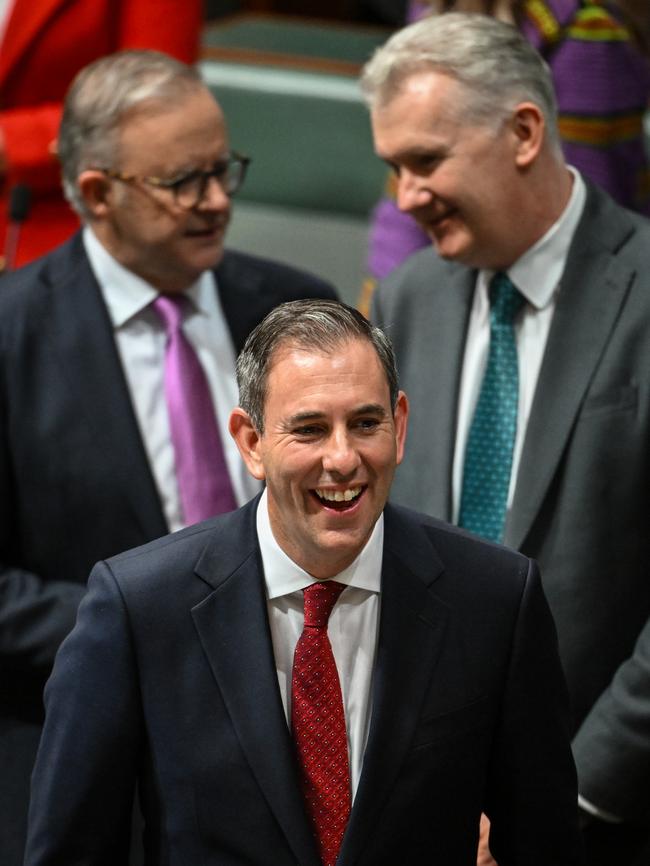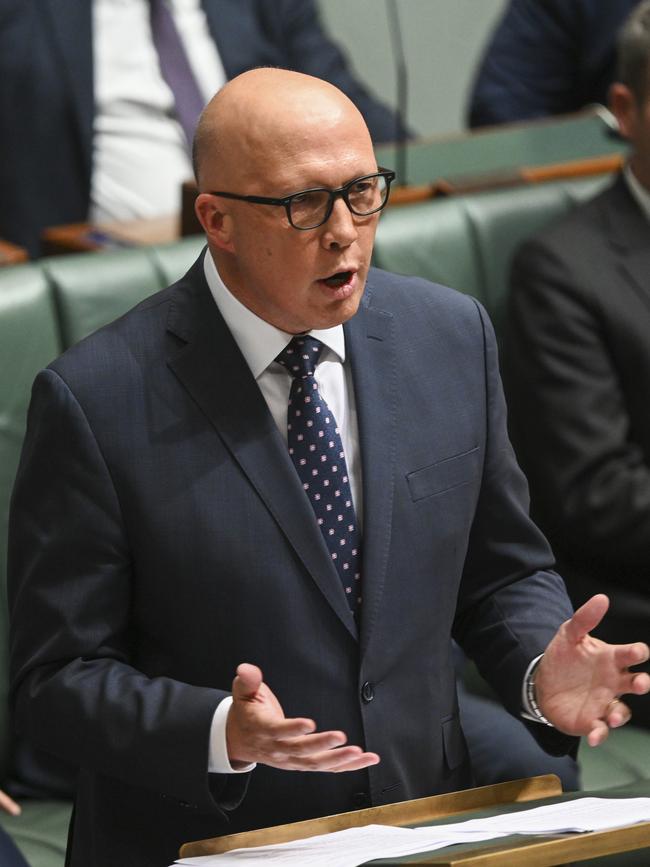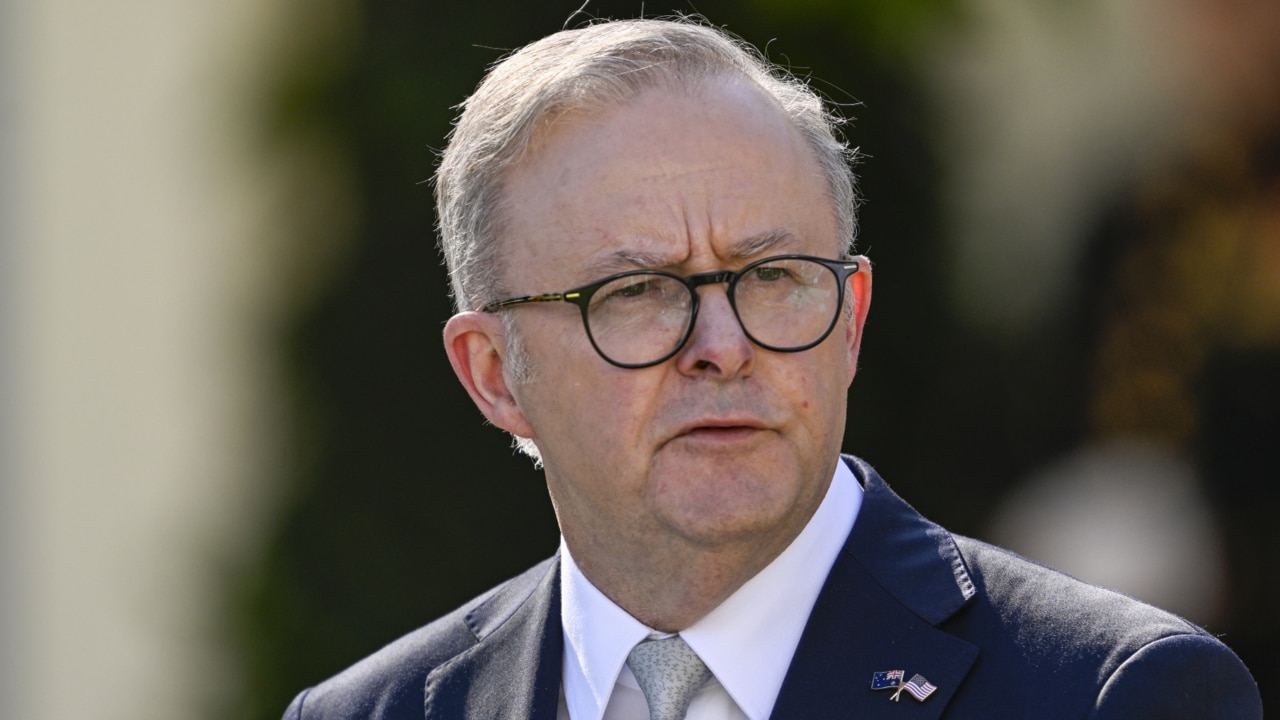Albanese, Dutton make their pitch as battle heats up for Australia’s political soul
Anthony Albanese seeks to transform Australia while Peter Dutton talks small, simple and suburban.

Dutton’s promise at the next election is to dismantle the Albanese-Chalmers agenda. The Opposition Leader accuses Labor of setting Australia on a “dangerous course” with the “wrong priorities” – pledging a “back to basics” approach to the economy, green energy, mining, immigration, industrial relations, law and order and controls on digital platforms.
In his reply to the budget Dutton invested his leadership with a new mission – to purge Australia of the Albanese-Chalmers transformation vision. Jim Chalmers’ ambitious, defining but risky third budget is Dutton’s target. The Liberal leader seeks to turn Labor’s agenda against itself.
Dutton wants the next election to become a referendum on the way Anthony Albanese and his government “have changed our country”. He will run on an updated Howard “battlers” platform. He pitches to the unorganised workers, the middle class, families, the home hunters, the cost-of-living strugglers, small business, the powerless and those who think Australia is being hijacked by elites who aren’t up to the job.
Dutton has identified a range of policy principles on which he will run. The details are still thin. The economic policy is not on the table. But his pitch is powerful and strikes at Labor’s’ vulnerability. His narrative resembles the people v institutional power. The list of vested interests Dutton is alienating is long – big business, big universities, big unions, big super funds, big renewable industry.
His reply to the budget relies on three ideas – that people think the country is heading in the wrong direction, that they are dissatisfied with their lot and that they prefer an end to Labor’s so-called reforms, visions and experiment with the failed voice still sighted in the rear-view mirror.
In the process Dutton is making himself a target. Labor’s political blowtorch will be extreme – the party has only one option: to destroy Dutton as a viable political force. From this point, the contest will be prolonged and bitter. The question for the Coalition is obvious: is it up to the job? This is an unreformed Liberal Party and there must be severe doubts about its ability to formulate the policies to give effect to Dutton’s strategy.


Where Chalmers talks about Labor addressing “the biggest transformation in the global economy since the industrial revolution”, the fourth evolution of the Australian economy and massive shifts in the industrial base to make the nation a renewable energy superpower, Dutton talks small, simple and suburban.
Dutton says: “I know how to make the decisions to get our country back on track.” Labor misjudges how many people it has irritated. Dutton talks kitchen table politics. He is tapping into fears about cost of living, neighbourhood safety, power prices, too many migrants, the housing crisis, pressure to buy electric cars, green ideology and pro-Palestinian demonstrations across the country. Above all, Dutton is pitching to an Australia that Labor wants to change. It is noteworthy that Labor’s transformation agenda is actually far removed from the cautious mandate that Albanese won in 2022.
By this appeal Dutton aspires to unite a centre-right voting coalition against Labor. It looks weak in the teal-held seats but has the potential to win traction in the suburbs and regions.
Whether Dutton can put policy flesh on the bones is highly debatable. Enunciating a campaign against Labor is a start. But Dutton has yet to show the Coalition and the Liberal Party is ready or fit to govern or, when the details come, whether it has a credible policy.
For two years the Coalition has lived off exploiting high inflation and Labor’s blunders. Its capacity to devise and sell an agenda that is responsible, differentiated from Labor yet persuadable must be in doubt. Yet Dutton’s speech will instil some hope into the ranks. As for Dutton, he will need to combat Labor attacks that he is a throwback, a nostalgist lost in the contemporary world.
The trap for Labor progressives, however, is to repeat their blunder with the voice referendum, to believe their propaganda, to patronise too many people and to underestimate Dutton.
Much hinges on the economy. Chalmers has brought down an audacious yet unorthodox budget, littered with initiatives, yet trying to do too much for too many people. The budget has two vulnerabilities – whether Chalmers has misjudged the inflation challenge with interest rates staying higher for longer and the extent to which Labor’s Green Industry/Future Made in Australia vision is littered with unacceptable risks. For the record, Dutton has a lot of professional economic support on both fronts.

The heat is on Labor and the political reaction to the budget. The immediate aim of budget 2024 is to resurrect the sense of purpose Labor needs. In the budget Chalmers pivoted and spent up big. Consider the spread of budget benefits: a tax cut for all taxpayers (the average cut being $36 a week), energy bill rebate relief for every household (at $75 a quarter), freezing the cost of medicines, stronger Medicare, a 10 per cent boost to rental support, extra funds for housing, cutting student debt – and massive funds and plans for renewable energy.
It is a strong retail politics budget. It gives every Labor MP a powerful agenda to sell. But will it work politically? The omens aren’t encouraging. The stakes are vast: Labor is looking at its re-election and desperate to avoid being driven into the long death throes of minority government.
Dutton, judged on this speech, is not running a small-target strategy. Offsetting this, most of his proposals have an electoral or populist appeal. He wants to fight Labor on the economy, housing, immigration, energy and industrial relations by seeking significant policy differences.
Pledging to rein in spending, Dutton opposed Labor’s $13.7bn production tax incentives for hydrogen and critical minerals, branding it “corporate welfare for billionaires”, saying projects should stand on their own, thereby repudiating a centrepiece of Labor’s long-range agenda.
But he pledged to cut back regulation, declared he was pro-mining and that he wanted mining to boom in Western Australia and around the nation.
On industrial relations Dutton promised to amend the law and revert to the former definition of a casual worker in the interests of small and family business. How far he repeals the rest of Labor’s IR laws remains to be seen. To address the housing crisis the Coalition will impose a two-year ban on foreign investors and temporary residents purchasing existing homes in Australia. It will cut the permanent migration program by 25 per cent – from 185,000 to 140,000 for two years with increases to 150,000 and 160,000 in years three and four.
The refugee and humanitarian program would be cut by a third to 13,750. The Coalition would set a cap on foreign students and enhance the integrity of the student visa program. Dutton will attract the ire of the higher education industry and risk the hostility of ethnic groups sure to be mobilised by Labor.
Dutton said his aim was to free up more than 100,000 additional homes across the next five years and said on the current trajectory Albanese’s pledge to build 1.2 million homes by 2029 was falling short by 400,000. He said his priority was the dream of home ownership, not the preferences of CEOs and big business. But business will oppose the reduction in skilled migrants and Labor will exploit this to the hilt.
Dutton wants a wide-ranging fight on energy policy, backing nuclear, upgrading gas and seeking a lower priority for renewables. He reaffirmed his nuclear power pledge but gave no new details, saying the best approach was to locate new nuclear technologies on or near retired coal-fired plants. Dutton went hard on gas, pledging to ramp up domestic production and restore the Coalition’s National Gas Infrastructure Plan.
He said energy bills under Labor were untenable for households, farmers, businesses and manufacturers. He mocked Labor’s “made in Australia” agenda saying it would finish as a “future made abroad”. Branding Labor’s policy as “renewables only”, Dutton said safe and reliable power would be threatened, that rewiring the country would cost at least $1.3 trillion, that prices would keep rising and there was “no need” for 58 million solar panels, almost 3500 wind farms and 28,000km of new transmission poles and wires.
Labor will cast him as a renewable energy denier, resisting the global revolution and rejecting the economics. This seems certain to reinforce the socio-economic realignment of politics, with Labor winning more votes from higher-income, university-educated people and the Coalition drawing more backing from blue-collar, small business and tradies.
On law and order, Dutton promised to develop uniform knife laws across the country, tighten bail laws, increase offences for the use of phones and computers to threaten family members or partners, take a tougher line cancelling visas for dangerous non-citizen criminals, adopt a tough stand against anti-Semitism and make it an offence to post criminal acts online. Dutton’s populist pitches will provoke progressives.
The prospect looms of a culture war in tandem with the economic, energy and immigration battles. Obviously, Dutton will run on discriminating against non-citizens in the housing market, given the current housing crisis.
But Labor has no easy answer on housing. It compounded its problem by letting the post-pandemic net overseas migration numbers get out of control. The Reserve Bank warns there is no quick fix on housing – so Albanese is stuck with this dilemma through to voting day. The reality is that on many fronts Labor has virtually invited Dutton’s responses.
How will the public respond to this looming and divisive election contest? The country seems caught between an ambitious, unconvincing, high-risk Albanese government and a Dutton-led opposition pledged to purge Labor’s agenda, strong on criticism but yet to offer the details on a persuasive policy alternative. It is understandable but conspicuous that the Coalition has yet to reveal its full alternative personal income tax cuts package, sure to dominate much of the campaign.
The danger for Albanese and Dutton, as they battle each other, may be voter disillusionment with both sides. The public may finish making a choice around negatives, not positives, based on the “least-worst” option.
As the budget signalled, Labor presides over a slowing economy, ongoing cost-of-living pressures, still-high interest rates, weak productivity, years of flagging living standards and a central bank identifying the risk of “a rate of inflation and nominal wages growth that is persistently higher with no benefit to real wages”.
Chalmers’ third budget – the defining blueprint so far of the Albanese government – has triggered an avalanche of criticism from professional economists. Labor’s election year is bedevilled by the terrible conflict between the politics and the economics. The solution Chalmers hit on is clever, but too clever by half.
He recruits energy bill and rental assistance relief to secure a cut to the measured CPI, thereby reducing inflation by 0.5 of a percentage point in 2024-25, now saying inflation might be back within the zone (below 3 percent) by Christmas this year. Chalmers’ latest narrative is inflation will be “lower, sooner”.
In reality, his budget makes the Reserve Bank’s job more difficult. Independent economist Chris Richardson told this paper on budget night: “My test of the budget was that it didn’t poke the inflation bear. I don’t think it passed that test.” KPMG chief economist, Brendan Rynne said: “The budget is too stimulatory. This places inevitable upwards pressure on inflation. If the government is wrong, the implication is for the cash rate to stay higher for longer.”
The further problem with using the budget to “buy” a lower CPI is that the subsidy frees up funds to be spent elsewhere, raising overall demand and putting pressure on underlying inflation. In a remarkable comment, Energy Minister Chris Bowen told the ABC the reason Labor applied energy bill relief to everyone was “to maximise the impact” on inflation, the point being the broader the relief, the more measured CPI was reduced.
University of NSW economics professor Richard Holden told Inquirer: “I think the Treasurer’s claims are dishonest. He is not levelling with the Australian public. Subsidies are stimulus and they will put upwards pressure on inflation.”
Judo Bank chief economist Warren Hogan told Inquirer: “This is a ploy to convince people the government is putting downward pressure on interest rates. And if anything goes wrong that it’s the fault of the Reserve Bank. The budget’s forecast fall in inflation is all due to the technical reduction in measured inflation but that’s got nothing to do with the impact of real inflation. The subsidy will increase demand and add to inflation pressures in the economy. The message being sent is that the government is not responsible for high interest rates. They are lining up to put the blame on the Reserve Bank – and that is the opposite of genuine leadership.”
Chalmers says his aim in the budget is “to fight inflation without smashing the economy”. Yet he has brought down an expansionary budget at a time of high inflation and that’s an economic risk. The Treasurer points to his back-to-back budget surpluses – something not achieved in nearly two decades – as proof of responsible disciplined policy.
But he oversells and misleads.
Over the coming year the budget “bottom line” falls away from a surplus of $9.3bn to a deficit of $28.3bn in 2024-25, a deterioration of nearly $38bn. While Chalmers boasts of spending restraint, spending in real terms increases by 4.5 per cent in the year just ending and will increase by an estimated 3.6 per cent in the coming year. That’s not restraint.
And what happens after these two surplus budgets? There are budget deficits as far as the eye can see for a full decade. Chalmers rarely mentions the single most important event in the Australian budgets – the record terms of trade due to high commodity prices.
Richardson said: “The world has given us a stunning pay rise. There have been elements of this over the past 20 years, but it has recently reached new highs. It won’t last forever but it will last longer than the government has in its figuring.
“This is a national pay rise of about $100bn a year over and above what we used to get. It’s not because of anything we’ve done better but because the world changed. In revenue terms, there has never been a better backdrop for the budget, not since before Australia was Australia, since before Federation.”
Richardson points out that budgets from this point will increasingly get harder. The terms of trade won’t disappear overnight but that will happen over time. On the spending side, the big drivers will be the defence budget and the caring/social services area where the National Disability Insurance Scheme and aged care will be most conspicuous.
There are two conclusions. “The current situation is as good as it gets for budgeting in Australia,” Richardson said. And the best ever revenue situation meant the government should have achieved far more – its surplus position should be stronger.
Australia is witnessing a bigger spending government. Spending as a proportion of GDP is 26.4 per cent in 2024-25 and 26.6 per cent the following year. Apart from the emergency spending during the pandemic these are the highest figures for nearly 40 years. And a permanently higher level of government spending means a permanently higher level of taxation.
That’s not the whole story. Labor’s renewable energy power ambition tied to its Future Made in Australia vision will give state power a permanently elevated status – government will set the direction for new industries, provide tax incentives and subsidies, and serve as a catalyst to generate private capital. This is Chalmers’ vision for the fourth stage of Australia’s economy.
It makes the coming election a rare event – not just about the short term but about a mandate for one of the most far-reaching economic programs ever put to the people.






Australia faces a sharp economic and cultural conflict over the nation’s direction – between the government-driven, renewable energy, progressive vision of Albanese Labor and the Back on Track restoration pitch from Coalition leader Peter Dutton pledging to terminate the Labor experiment.